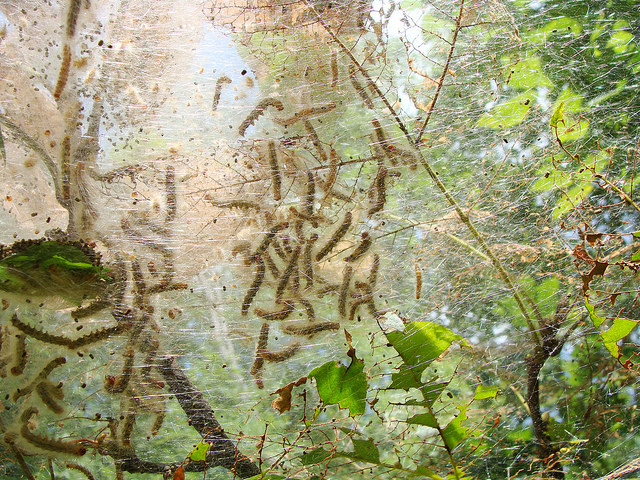Another good year for fall webworms
By Mary Hightower
The Cooperative Extension Service
U of A System Division of Agriculture
Fast Facts:
- Webworms abundant across Arkansas
- Numbers may look scary, but the worms won’t kill trees
(260 words)
(Newsrooms: with art at www.flickr.com/photos/uacescomm/21813921995, www.flickr.com/photos/uacescomm/21767960366, www.flickr.com/photos/uacescomm/21782351332)
BENTONVILLE, Ark. -- Those creepy worm-filled web tents on trees across Arkansas aren’t early Halloween decorations but fall webworms.
“You’ve probably noticed the webs. There aren’t many persimmon, hickory, or walnut trees without them,” said Neal Mays, Benton County extension agent for the University of Arkansas System Division of Agriculture. “Fall webworms have the tenacity of an Olympic athlete and the appetite of a teenager, and a good number of infested trees contain more web than leaves this year.

“The good news is these caterpillars don’t kill trees, but they can sure make trees look bad,” he said.
Female moths lay eggs on the leaves, and after hatching, small caterpillars feed on the leaf surface. As they grow, larger caterpillars will eat the entire leaf. Once all leaves in the web have been consumed the worms move up or down the limb, spin more web, and continue feeding for up to five weeks. Only this year’s leaves are consumed and the limbs and buds inside are unharmed. Multiple generations are common in the same year. Population size is cyclical, and worm numbers usually decline after two or three years of heavy infestation.
If control is desired, webs and worms can be cleared from tree limbs or affected limbs can be pruned and destroyed.
“However, pruning may damage the shape and appearance of small trees, or be impossible if webs are in upper branches of large trees,” Mays said. “Chemical control measures include use of bifenthrin or Sevin. A “natural” product that may provide control is Bt, which stands for a bacterium, Bacillus thuringiensis. However application of all these protectants may be difficult or impossible in large trees. Always apply pesticides according to label instructions.”
For more information, contact your county extension office or visit www.uaex.uada.edu.
Pursuant to 7 CFR § 15.3, the University of Arkansas System Division of Agriculture offers all its Extension and Research programs and services (including employment) without regard to race, color, sex, national origin, religion, age, disability, marital or veteran status, genetic information, sexual preference, pregnancy or any other legally protected status, and is an equal opportunity institution.
# # #
Media Contact: Mary Hightower
Dir. of Communication Services
U of A Division of Agriculture
Cooperative Extension Service
(501) 671-2126
mhightower@uada.edu
Related Links